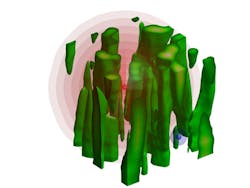Champaign, IL--Led by University of Illinois physics professor Brian DeMarco, researchers have demonstrated that laser light can completely localize atoms in the first direct observation of three-dimensional (3D) Anderson localization of matter. The observation will increase the understanding of how 3D conduction is affected by the defects that plague materials, an important finding for many electronics and imaging applications.
The complete localization of quantum matter waves in three dimensions, first theorized roughly half a century ago, was detailed in the October 7 issue of the journal Science. Defects in materials are inevitable, but their effects are poorly understood. Understanding how disorder in a material affects waves traveling through it has implications for many applications, including ultrasonic waves in medical imaging, lasers for imaging and sensing, and electron waves for electronics and superconductors. “The physics behind disorder is fundamental to understanding the impact of unavoidable material imperfections on these kinds of applications,” DeMarco said. Scientists have long theorized, but never observed, that strong disorder causing interference on all sides can trap a matter wave in one place, a phenomenon known as Anderson localization.
DeMarco says that Anderson localization is analogous to a trumpeter playing in a concert hall filled with randomly placed barriers that reflect sound waves. Instead of traveling in all directions, the sound stays at its source, never propagating outward because of destructive interference. "The result? Perfect silence everywhere in the concert hall. The trumpeter blows into his instrument, but the sound never leaves the trumpet," says DeMarco. "That’s exactly the case in our experiment, although we use quantum matter waves instead of sound, and the barriers are created using a speckled green laser beam."
To simulate electrons moving in waves through a metal, the group uses ultra-cold atoms moving as matter waves in a disordered laser beam. Using laser light as an analogy for a material allows the researchers to completely characterize and control the disorder—a feat impossible in solids, which has made understanding and testing theories of Anderson localization difficult. "This means that we can study Anderson localization in a way that is relevant to materials," DeMarco said. "Now, theories of Anderson localization in 3-D can be compared to our ‘material’ and tested for the first time."
The team also measured the energy a particle needs to escape localization, known as the mobility edge. By tuning the power of the speckled green laser beam, the researchers measured the relationship between the mobility edge and disorder strength. They found that as disorder increased, so did the mobility edge, meaning that materials with high concentrations of defects induce more localization.
DeMarco plans to use his measurements of Anderson localization and the mobility edge along with future work exploring other parameters to engineer materials to better perform specific applications--in particular, high-temperature superconductors.
SOURCE: University of Illinois; http://news.illinois.edu/news/11/1007waves_BrianDeMarco.html

